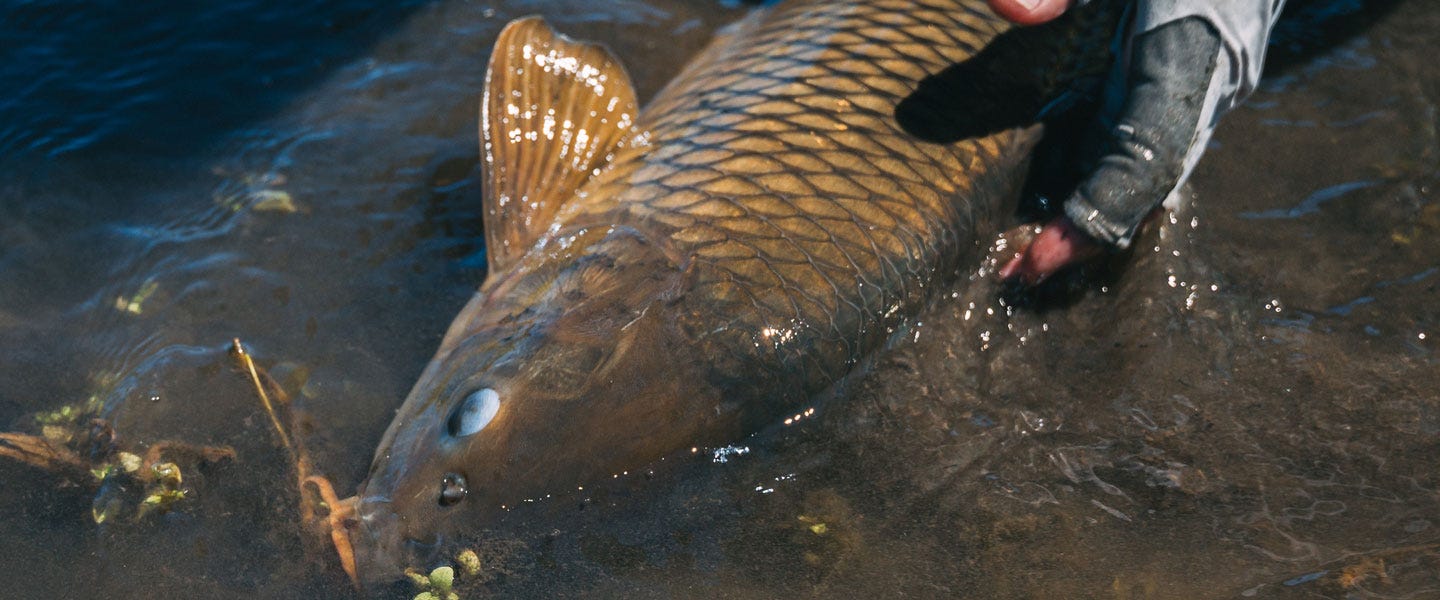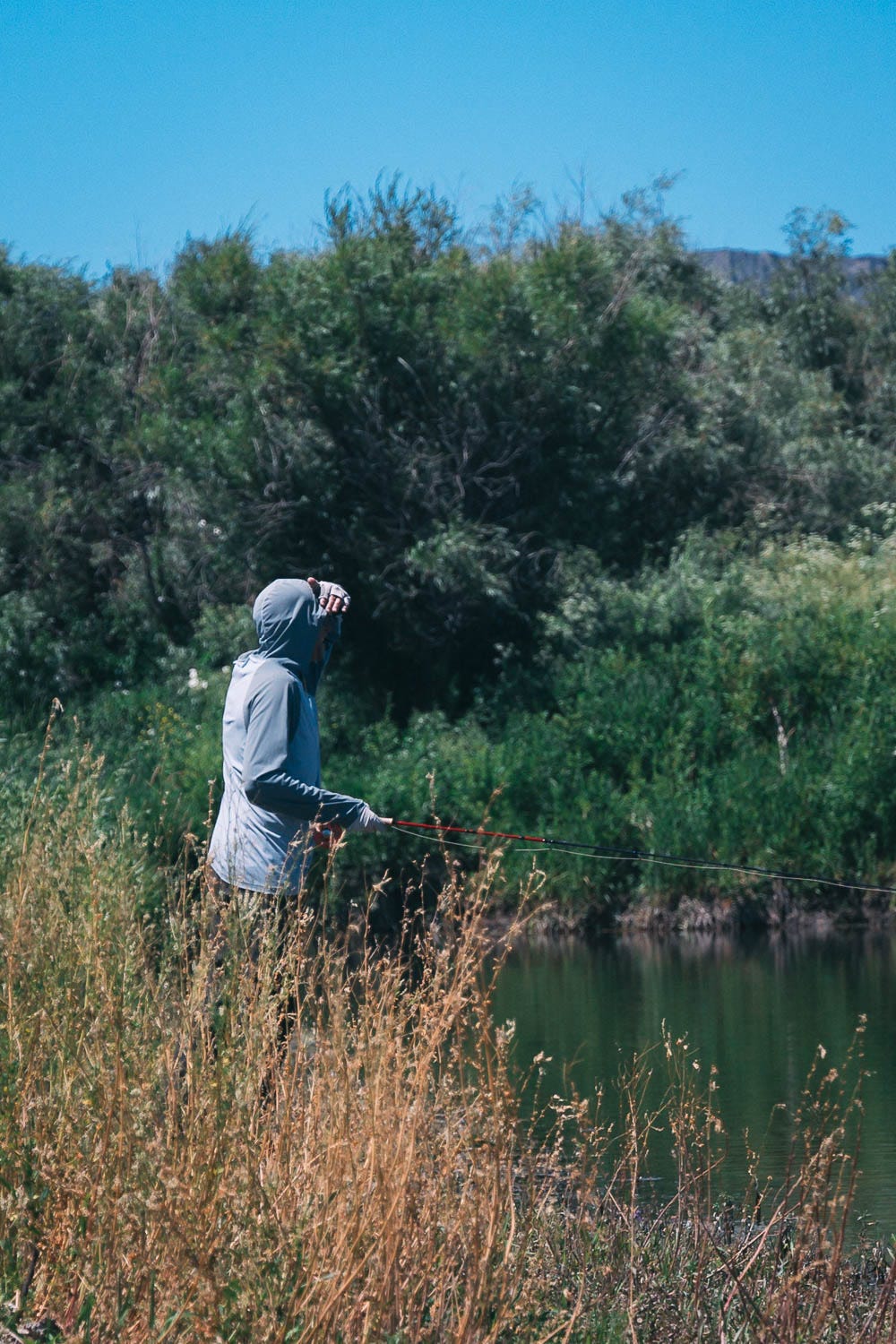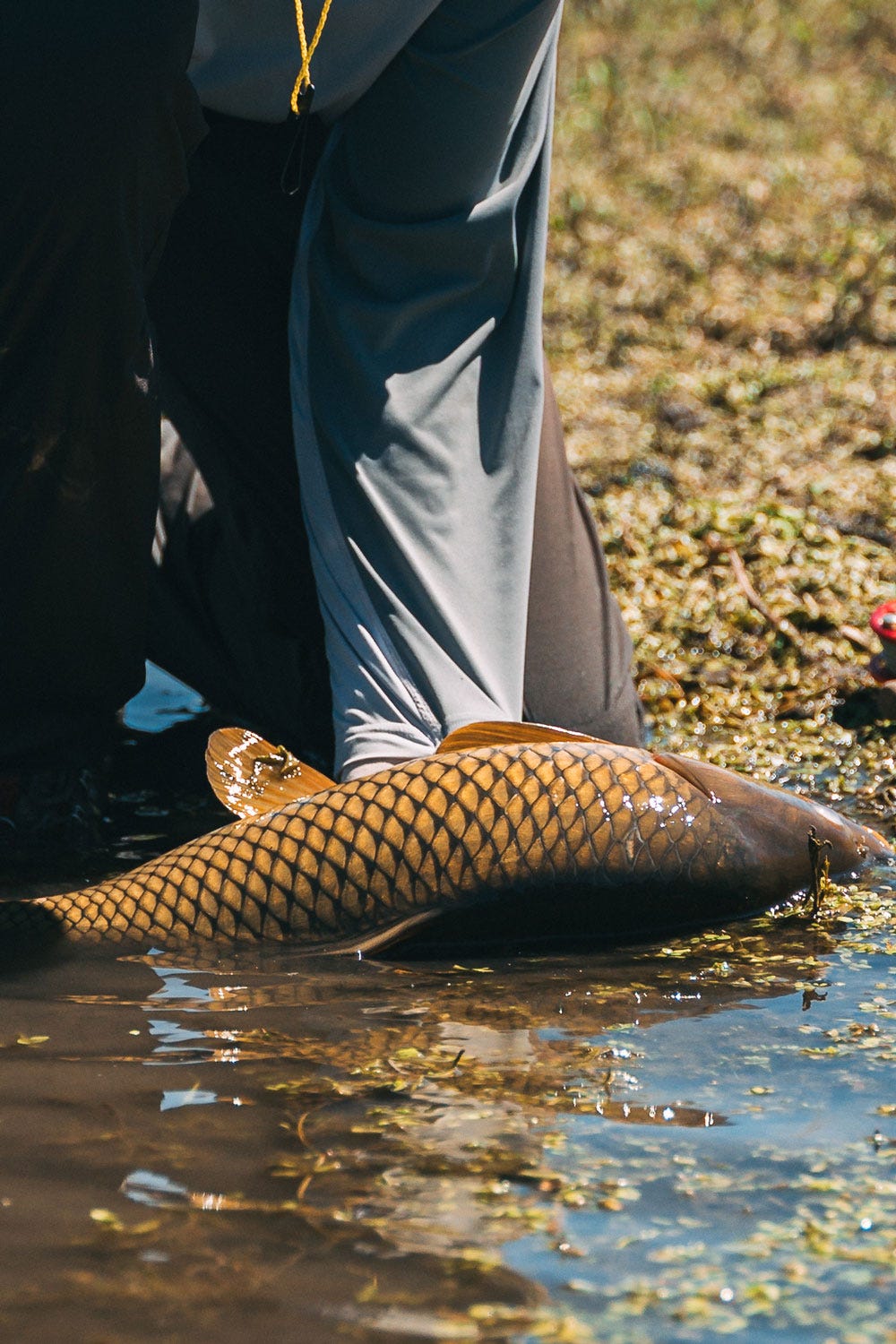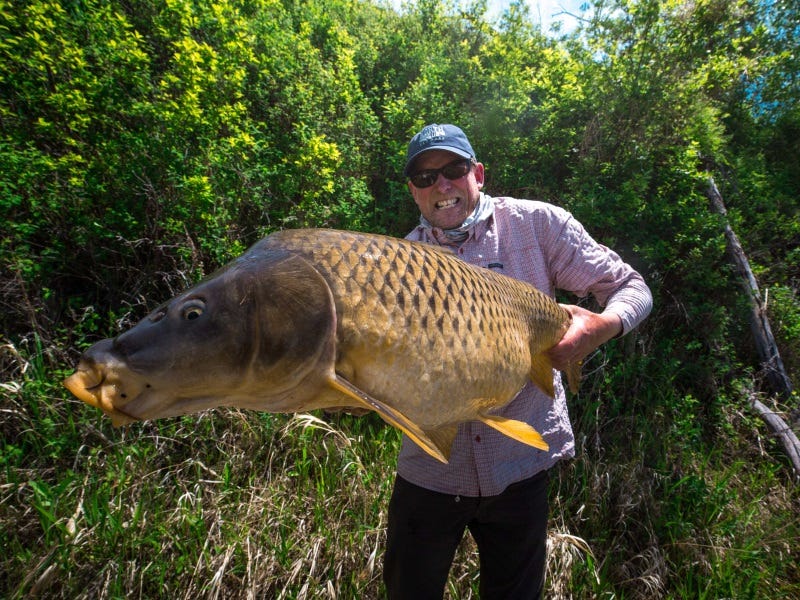How do you catch carp on a fly rod?

Overlooked by most anglers, this monstrous fish can make the day.
By Fred Telleen
Really . . . Carp?
A question I’m often asked is this: “What are you tying?”
When I’m tying trout or steelhead flies people usually say, “Let me see that,” and they sit down to chat. But when I say, “I’m tying carp flies,” they get a perplexed look on their face and say, “Really? You fly fish for carp? Don’t they just eat garbage off the bottom?
Those experiences make me believe that most anglers have a very low opinion of carp. Whether their opinion stems from misinformation or misunderstanding, they don’t view carp as worthy fish. The fact that carp do not have gamefish status in Montana and elsewhere, and are often shot with arrows and left to rot, does not help their image.
I saw my first carp in Lake Michigan as a kid and I’ve run into them in many places over the years. I decided to try fly fishing for carp one spring in some Colorado River backwaters near Grand Junction. Initially, they were a big challenge and the more I have learned about them over the years, the more I’ve come to respect them.
Wanna read more about catching carp?
What is so special about Cyprinus carpio?
Did you know that carp are in the minnow family? The common carp (there are several species) is native to Eastern Europe and Asia. “Commons” have been spread worldwide as a food fish. They can live almost anywhere and they grow quickly. They have been farmed since Roman times (possibly earlier), made it to Great Britain in the 1300s, and were carried over to North America by the late-1800’s.
In North America, carp were intended to provide a quick food source, as a growing population decimates indigenous fish populations. Before long, carp were spread from coast to coast and today, they are largely regarded as invasive pests. In clean, unpolluted waters, they can provide excellent table fare. Unfortunately, they are primarily associated with poor quality waters where you definitely would not choose to eat them. Due to their versatile and voracious feeding natures, they also outcompete native fish.
Here's a cool carp pattern you can tie up for your next outing.
Carp are incredibly adaptable. They are able to survive in environments with low oxygen and in water temps pushing 90 degrees. When necessary, they can even gulp air to survive. As such, carp are often present in urban environments and in poorly maintained and polluted water. The fact that we often find them in nasty places is a reflection of the state of many of our waterways rather than a reflection on the carp themselves.
Just because carp can survive in harsh, low-oxygen environments does not mean you won’t find them in high-quality waters. Anglers are discovering that carp are worthy gamefish and are found close to most anglers. In fact, carp are common in some of the West’s best trout rivers, including my current Montana home water, the Missouri River.
Carp are omnivorous and able to find nutrients by eating almost everything. They will eat seeds, berries and certain vegetation. When a big mayfly hatch happens, they can be found sipping from the surface. I’ve also witnessed carp taking chironomids and caddis. Terrestrials, such as hoppers and cicadas, are routinely devoured if they find their way over feeding carp. At certain times, carp exhibit aggressive predatory behavior and chase minnows and small fish.
Like trout, carp are opportunistic when no specific food source is obvious. In general, they feed on all the same insects, worms, leeches, crayfish and minnows that trout eat. Unlike trout,
however, carp are not willing to wait for an insect hatch or for food to deliver itself. When needed, they create their own buffet.
Check out carp fishing in Tokyo.
Carp often feed in shallow, soft-bottom areas. They are uniquely adapted to do so. If no food is available, they root around on the bottom. They are able to vacuum up soft substrate and expel all the particulate (other than edible food) out of their gill slits. As they disrupt the bottom, they often dislodge the food they are after and they quickly vacuum up whatever nymphs, scuds, sow bugs, crayfish and aquatic worms they have uncovered. That’s what I’d call a highly adapted feeding behavior. Have you seen how big they are? They are apparently very good at what they do.
How do you catch them?
Given a carp’s varied diet, you might think that catching them would be easy. For the fly fisher, that is not always the case. Carp can be very challenging—often more so than trout. That’s because carp are very wary, especially when feeding in shallow waters. Prepare to be frustrated if you go after them.
I prefer to hunt and sight-fish for carp. Approaching and sight fishing carp bears strong similarities to stalking bonefish, redfish, and permit. Carp are a wary fish with highly developed senses. When spooked or disturbed, they can also emit a pheromone that warns other carp of danger. So, when you go after this wary fish in shallow water, stealth is in order.
When you spot a carp, you’ve got to get into position to deliver a fly without being seen. Then you’ve got to get the fly right in front of the fish so they discover it when they are ready to eat. You can’t cast at them. A splash down is going to send them ghosting away. Timing is everything. If you put the fly in front of them as they are mudding, they won’t see it. If you put it too far outside their feeding zone when they are moving, they will ignore it. It has to be just right. That, to me, is the fun. Sight fishing for carp is similar to dry-fly fishing, only you are watching your fly under the water.
What rod would you use to sight fish for carp?
I particularly enjoy hunting for carp from the bank. For me, it’s a casual pursuit. I’ll walk a shoreline until I find a fish working in close. I enjoy the walking and searching as much as the catching. When I find a fish, I will dab or slide the fly right in front of their mouth until they vacuum it in . . . or leave. It’s pretty cool to watch them suck it up when your presentation works. When you see them eat your fly, pause for just a moment before setting the hook and you will find an easy purchase in Mr. Rubber Lips. Then its game-on. Make sure you’ve got plenty of backing. Carp have nearly spooled me numerous times. A typical run from a large fish will be 20-to 50 yards, but some fish keep on going, especially if you hook them on a shallow flat. Several consecutive runs can put them quite a distance from the angler as they head for a new zip code.

Tackle for Targeting Carp
I’ve hooked and landed large carp on five-weight rods and 4X tippet. This usually happens when trout fishing is slow and carp happen to be present. When carp are my intended target, I usually opt for a seven or eight-weight rod. On smaller rivers where carp are often under 10 pounds, a six weight is fine. But on the Missouri, where many fish are in the mid-to upper teens in weight, and can potentially exceed 30 pounds, you will appreciate the lifting power of a heavier stick.
When fishing clear water and shallow tailing fish, I typically opt for 10-12’ leaders tapered to 2X fluorocarbon. In some clear-water situations with small flies, I’ve even dropped to 3X. When the water is colored up or the fish have turned it muddy from feeding, you can get away with using 0X.
Tippet selection online right here.
Patterns to use for Carp
While carp can exhibit selective feeding behavior, the delivery of the fly is generally more important than the specific imitation. Getting the right sink rate is key to putting the fly where the fish can see it.
In clear, shallow water where the fish have good visibility, smaller and lighter flies are preferred. You don’t want the fly to splash noticeably and you don’t want it to sink too quickly. Often, an unweighted bugger or large nymph is ideal. If there is some current, or a weighted fly is necessary to reach the fish, I usually opt for bead-chain eyes or small brass dumbbells. The key is to slide or swing the fly gently into a carp’s feeding lane.
Here's our selection of fly tying materials so you can tie up your own variant.
When fish are working in colored or muddied water, you often need the fly to drop quickly, so you can pinpoint the spot where they have a chance of seeing it. A larger profile fly with weighted eyes that drops at a steep angle is often ideal in this situation.
I tie my carp flies with soft flowing materials, like rabbit fur and marabou. I often include rubber legs for action, color and to moderate the sinking rate. One of my favorites is a pattern I’ve developed called the Carpin Crunch. I tie it in small sizes with bead-chain eyes and in larger sizes with either 5/32” or 3/16” brass eyes. Olive is a productive base color. Rusty brown, tan and black are also good variations to carry.
The time to fly fish for carp is now!
During the heat of the summer and well into the fall, you can find plenty of options for great carp fishing. When trout have the warm-water blues, carp are getting fat and happy grubbing up nymphs, crayfish and minnows all day long. I often go out for an hour before or after work. Mornings and evenings are great times to find carp feeding in shallow water, but you can also find them working river edges in the middle of the day. As long as I have visibility, I’ll search for carp to cast a fly to . . . really!
Carp. The Outcast fish.
A question I’m often asked in the fly shop is “What are you tying?” When I’m tying trout or steelhead flies people usually say “Let me see that,” and they sit down to talk about it. But when I tell them “I’m tying carp flies,” they get a confused look on their face and say, “Really? You fly fish for carp? Don’t they just eat garbage off the bottom?”
Those experiences prove that most anglers have a very low opinion of carp. Whether their opinion stems from misinformation or misunderstanding, they don’t view carp as worthy fish. The fact that carp do not have gamefish status in Montana and elsewhere and are often shot with arrows and left to rot does not help their image.
I saw my first carp in Lake Michigan as a kid. I tried fly fishing for carp one spring in the Colorado River backwaters near Grand Junction. Initially, they were a challenge and the more I’ve learned about them over the years, the more I’ve come to respect them.




WHAT MAKES CARP A GAME FISH?
The common carp (there are several species) is native to Eastern Europe and Asia. “Commons” have been spread worldwide as a food fish. They can live almost anywhere, and they grow quickly. They have been farmed since Roman times (possibly earlier), made it to Great Britain in the 1300s, and were carried over to North America by the late-1800’s.
In North America, carp were intended to provide a quick food source, as a growing population decimates indigenous fish populations. Before long, carp were spread from coast to coast and today, they are largely regarded as invasive pests. In clean, unpolluted waters, they can provide excellent table fare. Unfortunately, they are primarily associated with poor quality waters where you wouldn’t choose to eat them. Due to their versatile and voracious feeding natures, they also outcompete native fish.
Carp are incredibly adaptable. They can survive in environments with low oxygen and in water temps pushing 90 degrees. When necessary, they can gulp air to survive. As such, carp are often present in urban environments and in poorly maintained and polluted water. The fact that we often find them in nasty places reflects the state of many of our waterways rather than reflecting on carp themselves.
Just because carp can survive in harsh, low-oxygen environments doesn't mean you won’t find them in high-quality waters. Anglers are discovering that carp are worthy gamefish and are found close to most anglers. In fact, carp are common in some of the West’s best trout rivers, including my home water, the Missouri River.
Carp are omnivorous and able to find nutrients by eating almost everything. They will eat seeds, berries, and other vegetation. When a big mayfly hatch happens, they can be found sipping from the surface. I’ve also witnessed carp taking chironomids and caddis. Terrestrials, such as hoppers and cicadas, are routinely devoured if they find their way over feeding carp. At certain times, carp exhibit aggressive predatory behavior and chase minnows and small fish.
Like trout, carp are opportunistic when no specific food source is obvious. In general, they feed on all the same insects, worms, leeches, crayfish, and minnows that trout eat. Unlike trout, however, carp are not willing to wait for an insect hatch or for food to deliver itself. When needed, they create their own buffet.
Carp often feed in shallow, soft-bottom areas and are uniquely adapted to do so. If no food is available, they root around on the bottom. They vacuum up soft substrate and expel all the particulate (other than edible food) out of their gill slits. As they disrupt the bottom, they often dislodge the food they are after and they quickly vacuum up whatever nymphs, scuds, sow bugs, crayfish, and aquatic worms they have uncovered in a highly adapted feeding behavior. Their sheer size proves they are very good at what they do.
HOW DO YOU CATCH THEM?
Given a carp’s varied diet, you might think that catching them would be easy. Think again. Carp can be very challenging—often more so than trout. Carp are very wary, especially when feeding in shallow waters. Prepare to be frustrated if you go after them.
I prefer to hunt and sight-fish for carp. Approaching and sight fishing carp bears strong similarities to stalking saltwater species like bonefish, redfish, and permit. Carp are a wary fish with highly developed senses. When spooked or disturbed, they can also emit a pheromone that warns other carp of danger. So, if you choose to go after this wary fish in shallow water, stealth is in order.
When you spot a carp, get into position to deliver a fly without being seen. You’ve got to get the fly right in front of the fish, so they discover it when they are ready to eat. You can’t cast at them. A splash down is going to send them ghosting away. Timing is everything. If you put the fly in front of them as they are mudding, they won’t see it. If you put it too far outside their feeding zone when they are moving, they will ignore it. It must be just right. That, to me, is the fun. Sight fishing for carp is like dry-fly fishing, only you are watching your fly under the water.
I prefer hunting for carp from the bank. For me, it’s a casual pursuit. I’ll walk a shoreline until I find a fish feeding in close. Walking, searching, and observing fish is as enjoyable as catching them. When I find a fish, I will dab or slide the fly right in front of their mouth until they vacuum it in or leave. Watching them suck up your fly when your presentation works is exhilarating. When you see them eat your fly, pause for just a moment before setting the hook. Then its game-on. Let’s hope you’ve got plenty of backing. Carp have nearly spooled me numerous times. A typical run from a large fish will be 20 to 50 yards, but some fish keep going, especially when you hook them on a shallow flat. Several consecutive runs can put them quite a distance from the angler as they head for a new zip code.
Gear for targeting carp
I’ve hooked and landed large carp on five-weight rods and 4X tippet. This usually happens when trout fishing is slow, carp happen to be present, and I don’t want to take the time to change up my rig. When carp are my intended target, I usually opt for a seven or eight-weight rod. On smaller rivers where carp are often under 10 pounds, a six weight is fine. On the Missouri, where many fish are in the mid to upper teens in weight potentially exceeding 30 pounds, you will admire the lifting power of a heavier stick.
When fishing clear water and shallow tailing fish, I typically opt for 10-12’ leaders tapered to 2X fluorocarbon. In some clear-water situations with small flies, I’ve even dropped to 3X. When the water is colored up or the fish have turned it muddy from feeding, you can get away with using 0X.
Fly Patterns to use for carp
While carp can exhibit selective feeding behavior, the delivery of the fly is more important than the imitation. Getting the right sink rate is key to putting the fly where the fish can see it.
In clear, shallow water where the fish have good visibility, smaller and lighter flies are preferred. You don’t want the fly to splash and you don’t want it to sink too quickly. Often, an unweighted wooly bugger or large nymph will do the trick. If there is current and a weighted fly is necessary to reach the fish, I usually opt for bead-chain eyes or small brass dumbbells. The key is to slide or swing the fly gently into a carp’s feeding lane.
When fish are working in colored or muddied water, you’ll need the fly to drop quickly so you can pinpoint the spot where they have a chance of seeing it. A larger profile fly with weighted eyes that drops at a steep angle is a good choice in this situation.
I tie my carp flies with soft flowing materials, like rabbit fur and marabou. I often include rubber legs for action, additional color, and to moderate the sinking rate. One of my favorites is a pattern I’ve developed called the Carpin Crunch. I tie it in small sizes with bead-chain eyes and in larger sizes with either 5/32” or 3/16” brass eyes. Olive is a productive base color. Rusty brown, tan and black are also good variations to carry.
Best conditions for carp
During the heat of the summer and well into the fall, you can find plenty of options for great carp fishing. When it’s too hot for trout, carp are getting fat and happy grubbing up nymphs, crayfish, and minnows all day long. I often go out for an hour before or after work. Mornings and evenings are great times to find carp feeding in shallow water, but you can also find them working river edges in the middle of the day. Give trout a break in the summer heat, expand your fly fishing portfolio, and challenge yourself to catch a carp.




